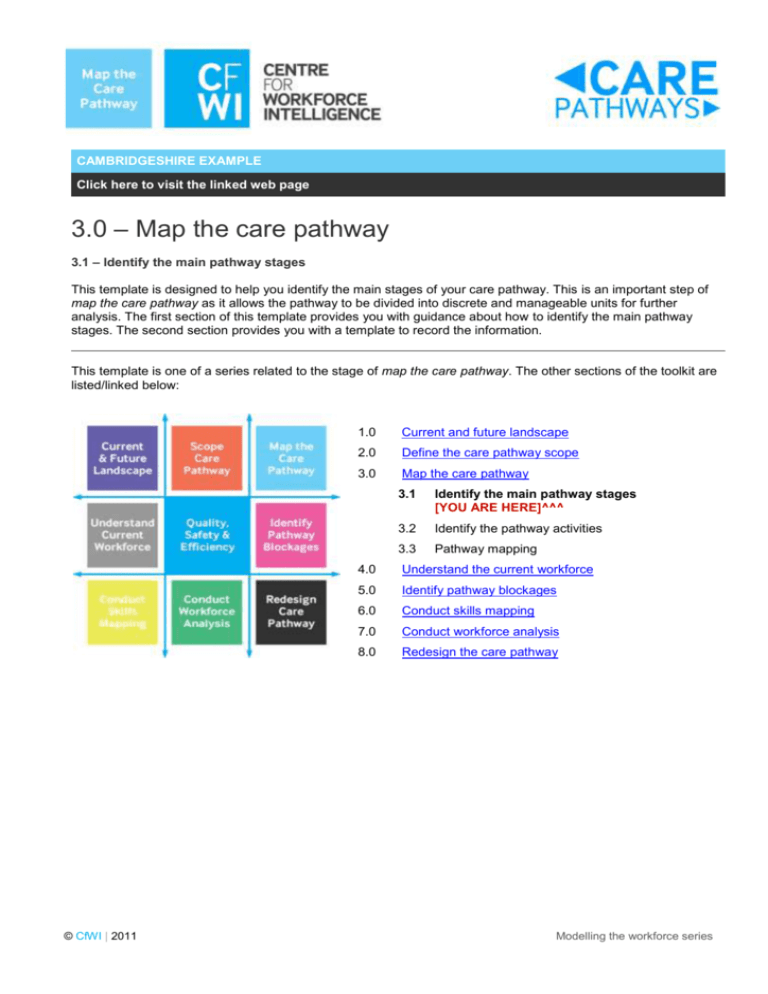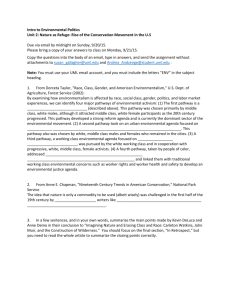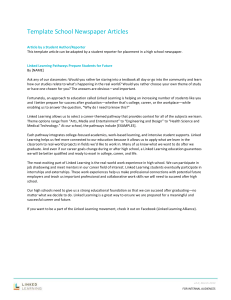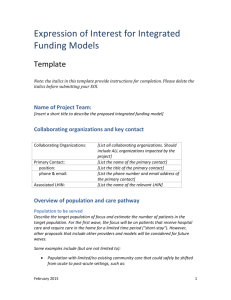Example
advertisement

CAMBRIDGESHIRE EXAMPLE Click here to visit the linked web page 3.0 – Map the care pathway 3.1 – Identify the main pathway stages This template is designed to help you identify the main stages of your care pathway. This is an important step of map the care pathway as it allows the pathway to be divided into discrete and manageable units for further analysis. The first section of this template provides you with guidance about how to identify the main pathway stages. The second section provides you with a template to record the information. This template is one of a series related to the stage of map the care pathway. The other sections of the toolkit are listed/linked below: © CfWI | 2011 1.0 Current and future landscape 2.0 Define the care pathway scope 3.0 Map the care pathway 3.1 Identify the main pathway stages [YOU ARE HERE]^^^ 3.2 Identify the pathway activities 3.3 Pathway mapping 4.0 Understand the current workforce 5.0 Identify pathway blockages 6.0 Conduct skills mapping 7.0 Conduct workforce analysis 8.0 Redesign the care pathway Modelling the workforce series Introduction DESCRIPTION OF THE STEP The stage map the care pathway allows you to understand who is doing what along the pathway. It feeds into the workforce analysis which will appraise different options for how the workforce can be utilised (referred to as scenarios within the eight-stage approach). As part of mapping the pathway, it is important to identify the pathway’s main stages. Dividing the pathway into discrete sub-units will make it easier to establish the main activities, and help identify who is carrying out these activities. RELEVANCE TO WORKFORCE Establishing the main stages of the care pathway allows the workforce to understand where their work fits into the pathway as a whole. This is important in terms of conveying the implication of certain functions on the rest of the pathway, e.g. if one activity is not completed, how does this impact on people working in other areas of the pathway? What are the knock-on implications? © CfWI | 2011 Modelling the workforce series The template DESCRIPTION OF THE TEMPLATE This template allows you to identify the main stages for your care pathway. A stage must be a discrete sub-unit have clear entry and exit factors/triggers contain a number of activities which move the patient/service user towards the conditions which need to be met for them to move to the next stage of the pathway. TEMPLATE The following table should be used to identify the main stages of the care pathway you will analyse as part of this process. Stage Name of stage What happens during the stage How the stage finishes 1 Pre-admission and upon A person presents at the The person is admitted admission A&E or is scheduled to to a hospital ward have a planned procedure The person has been admitted to a hospital ward and is due to begin investigations or treatment 2 Ongoing The person has been admitted to a hospital ward The person undergoes investigations or treatment The person is medically fit to be discharged from hospital 3 48 hours to Expected Date of Discharge (EDD) The person is medically fit to be discharged from hospital The discharge plan is finalised and a care package is arranged, as required The discharge plan has been finalised and everything is in place for the discharge 4 Upon discharge The discharge plan has been finalised and everything is in place for the discharge The person is The person is at home / discharged from hospital in another location in the and returns home / to community another location in the community 5 6 weeks post acute discharge The person is at home / The person receives a in another location in the care package, as community required © CfWI | 2011 How the stage starts 6 weeks have passed since the person was discharged from hospital Modelling the workforce series







